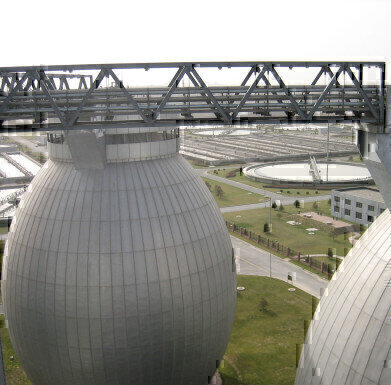Water/Wastewater
WABAG finalises the Xiaohongmen sludge treatment plant in Beijing
Jul 07 2009
The Xiaohongmen plant in south-east Beijing is the largest anaerobic sludge stabilisation plant ever to be completed by WABAG (Austria). Using the very latest technology, the sewage sludge from the wastewater treatment plant is dealt with in five bioreactors with a total volume of 60,000 m3. The five digester towers are impressive structures that now number among the technical sights in Beijing.
The Xiaohongmen wastewater plant in the Chaoyang District, which lies in the south-eastern corner of Beijing, is one of China’s largest treatment facilities. 600,000 m3 of wastewater derived from the area along the basin of the Liangshui River, where over two million people live, are treated daily. WABAG has completed a sludge treatment plant, which is equipped with advanced technology, for the stabilisation of the sludge emanating from biological wastewater cleaning. During the allocation of the project, the WABAG concept convinced the responsible commission due to the superior know-how available with regard to reliability, safety and energy consumption. The Beijing city administration and the World Bank jointly financed the project, which has cost around EUR 15 million. Advanced, energy-efficient technologies for low environmental impact The main plant units consist of mechanical sludge thickening, anaerobic sludge stabilisation, mechanical sludge dewatering with phosphor removal, and biogas recycling. With thickening as an initial phase, this concept allows a reduction in sludge volume and thus of the hydraulic load in the bioreactors in which the sewage sludge is subjected to controlled fermentation. The product of this process is flammable gas, which is converted into energy in heating boilers and gas motor units. This power is employed to drive fans, while in conjunction with the heat from biogas-fired boilers, waste heat is used for sludge heating in the digester towers and plant infrastructure heating. All in all, these measures add up to considerable savings with regard to plant operational costs, as well as a marked improvement in the overall CO2 balance of the Xiaohongmen wastewater treatment plant. The stabilised sewage sludge has a dry solids content of around 3 per cent. Following subsequent sludge dewatering, this content is raised to around 25 per cent, which significantly reduces volume and thus saves landfill space for further disposal. Opening up of an alternative energy source and a contribution to climate protection As a result of anaerobic stabilisation and the possibilities for the energetic use of the resulting biogas, sewage sludge is becoming increasingly important as an alternative source of energy. Depending upon the size of the respective plant, wastewater treatment facilities can cover up to 100 per cent of their own energy requirements, or the generated power is fed into the public grid for external use. If untreated sewage sludge is deposited on landfills, this involves enormous volumes and over the years, landfill gas, which plays an active role in the greenhouse effect, leaks into the atmosphere. Above all, the methane released has a major impact, as it is 21 times more greenhouse active than carbon dioxide. In terms of CO2 equivalents, the Xiaohongmen plant achieves a reduction in greenhouse gases of some 140,000 t annually. Using the BIOZONE®-AD, which has been furthered developed by WABAG, up to 40 per cent more methane can be extracted from sewage sludge, thus providing a notable improvement in both energy yield and climate protection. In addition, the ozone employed cracks micro-pollutants in the sewage sludge such as endocrine disruptors.Events
May 05 2024 Seville, Spain
May 13 2024 Munich, Germany
May 23 2024 Beijing, China
May 23 2024 Beijing, China
Jun 10 2024 Algiers, Algeria













